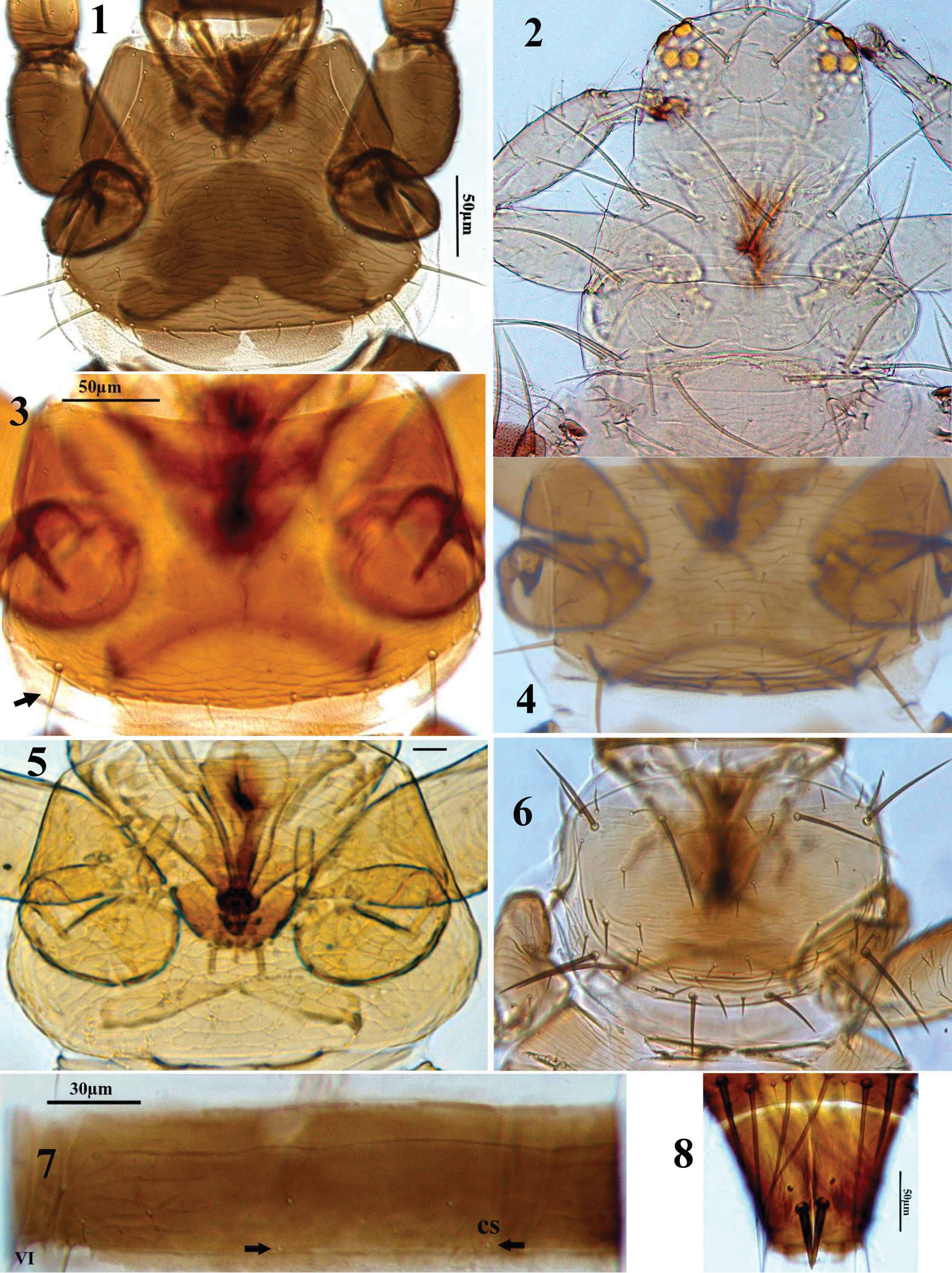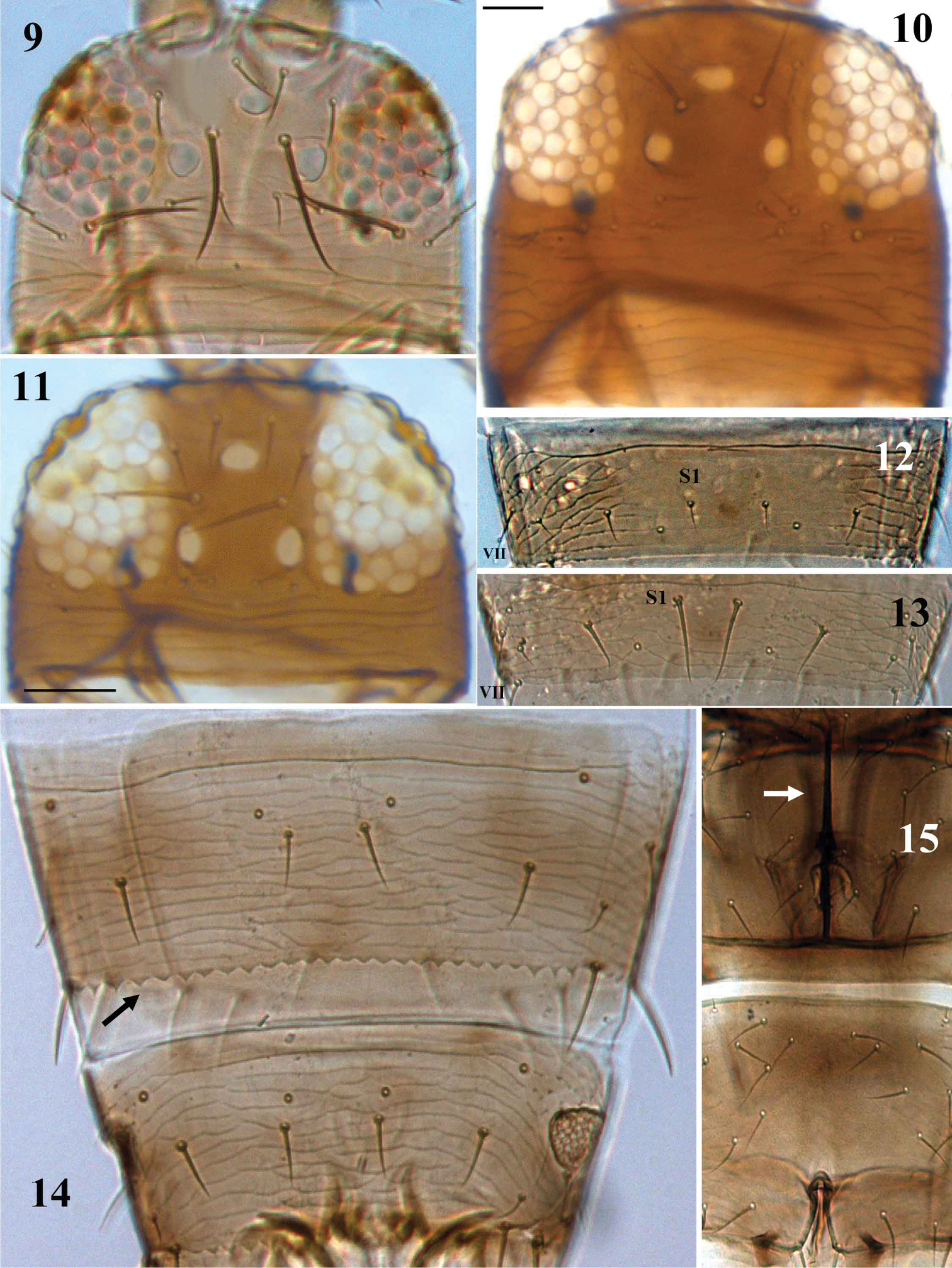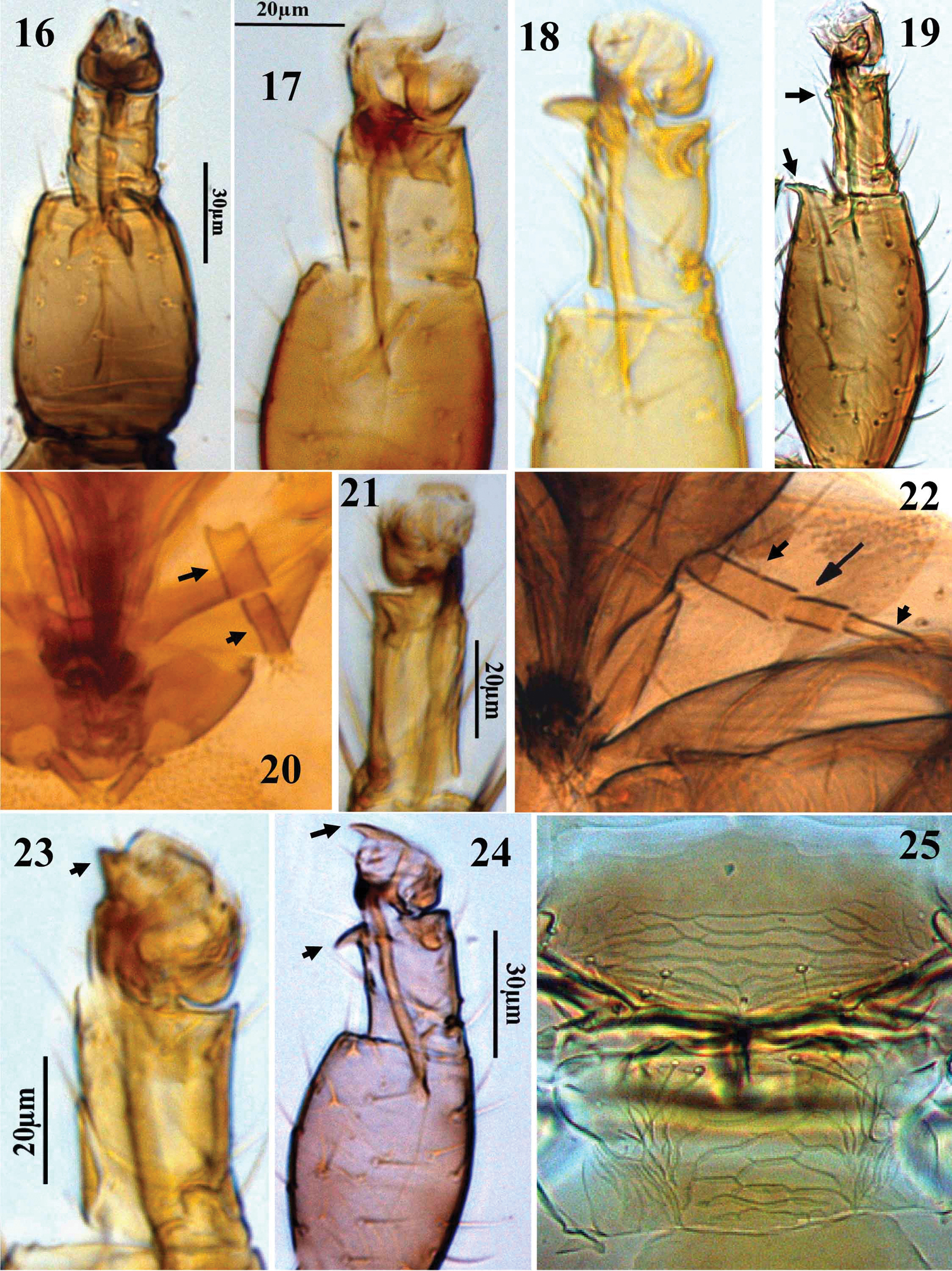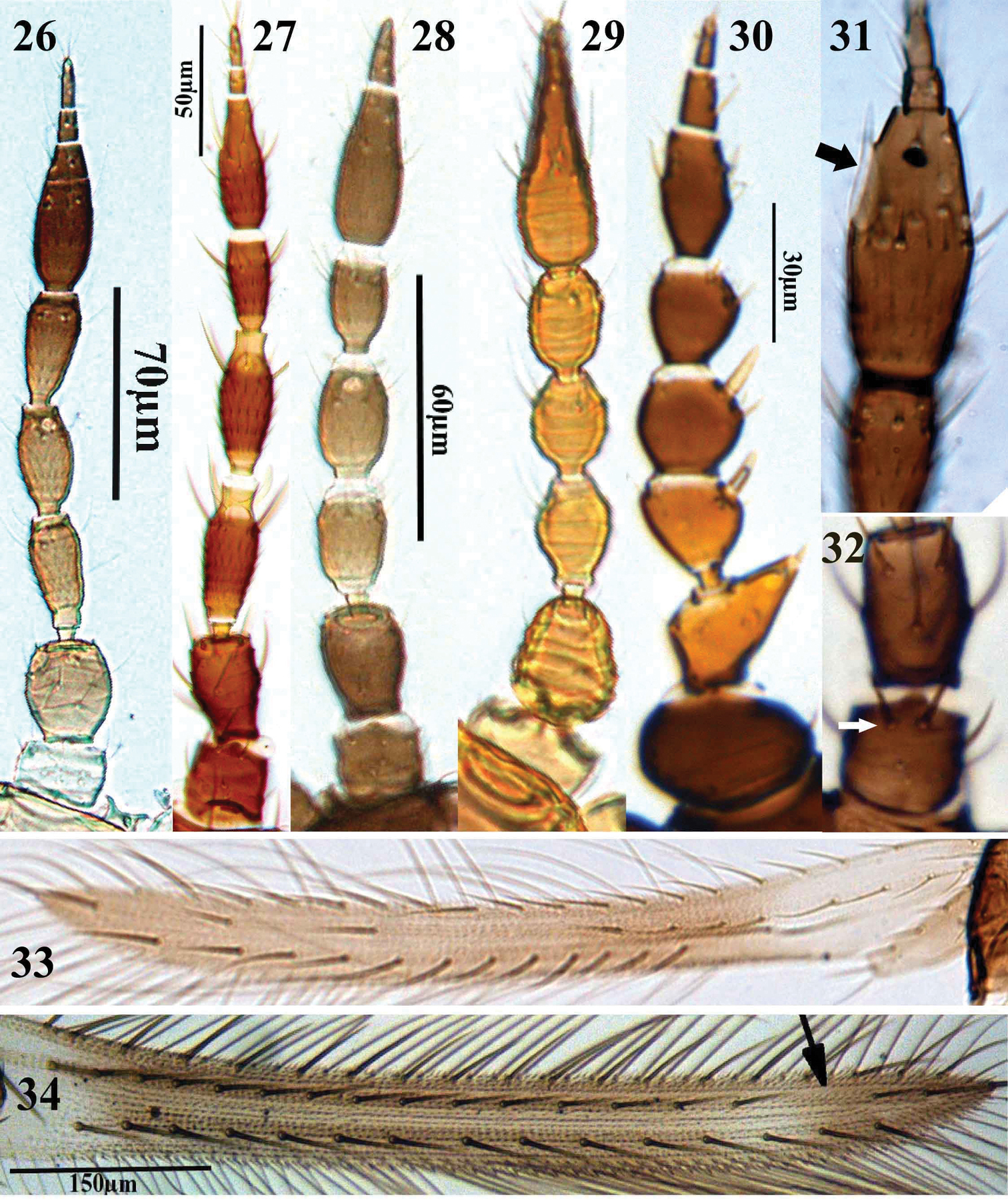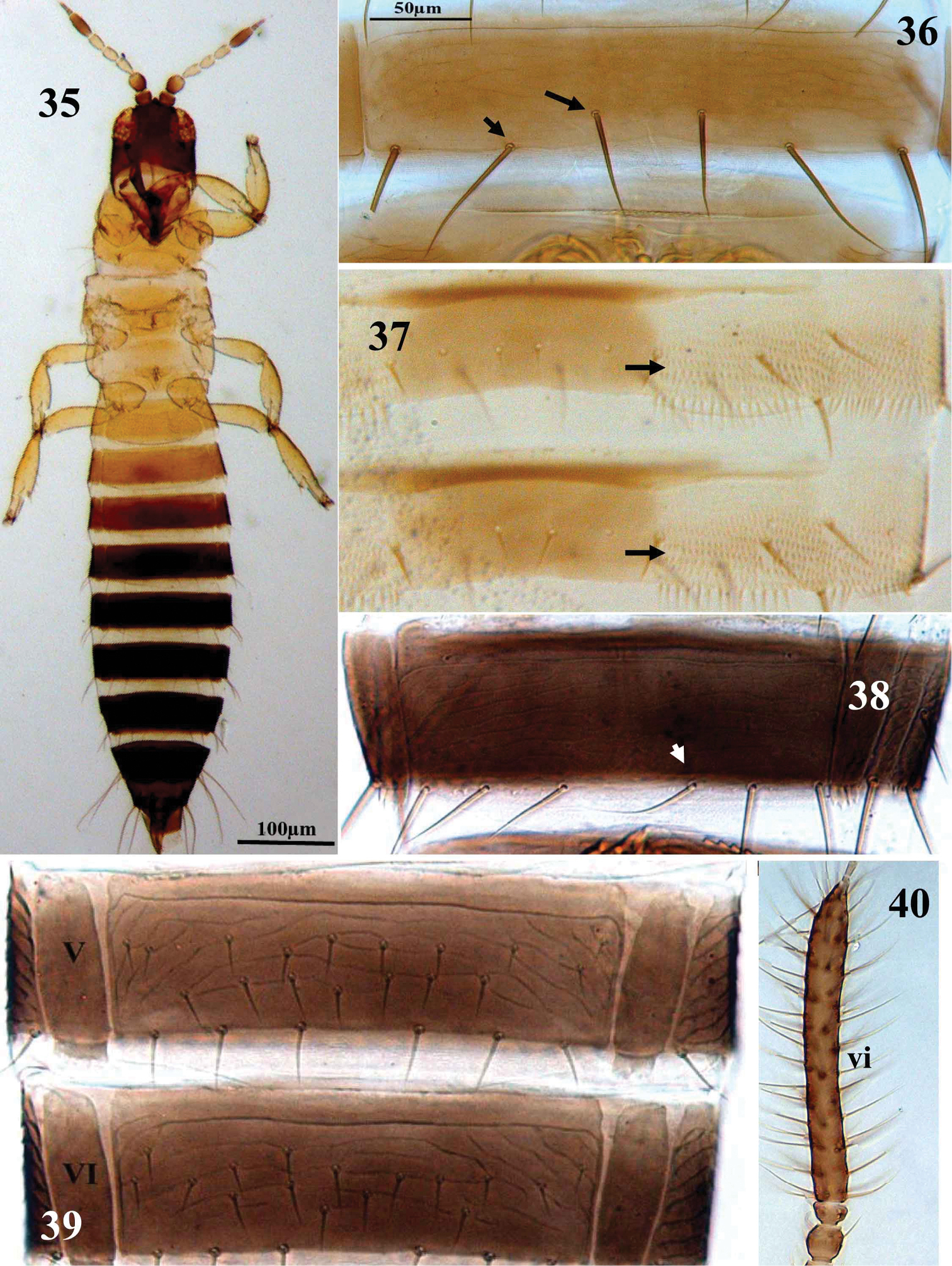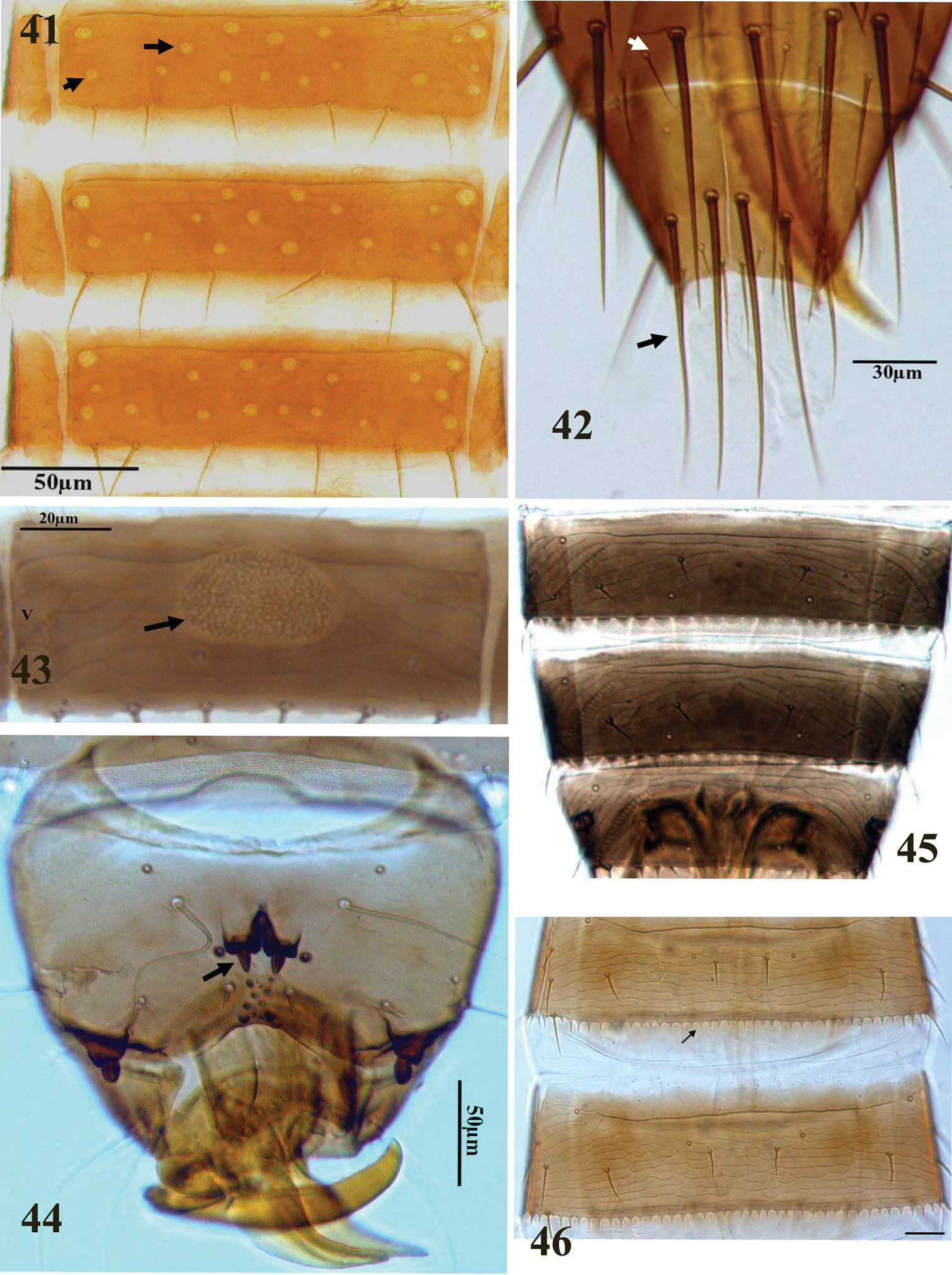






(C) 2013 Majid Mirab-balou. This is an open access article distributed under the terms of the Creative Commons Attribution License 3.0 (CC-BY), which permits unrestricted use, distribution, and reproduction in any medium, provided the original author and source are credited.
For reference, use of the paginated PDF or printed version of this article is recommended.
Citation: Mirab-balou M, Minaei K, Chen X-X (2013) An illustrated key to the genera of Thripinae (Thysanoptera, Thripidae) from Iran. ZooKeys 317: 27–52. doi: 10.3897/zookeys.317.5447
An illustrated key is provided for the identification of 35 genera of Thripinae (Thysanoptera: Thripidae) from Iran with comments for each genus. Chirothrips maximi Ananthakrishnan and Limothrips cerealium Haliday are recorded from Iran for the first time. A checklist is provided of Thripinae recorded from this country.
Thysanoptera, Thripinae, identification, Iran
The family Thripidae (Thysanoptera: Terebrantia) at present comprises more than 2000 described species, which are classified into four subfamilies, Thripinae, Dendrothripinae, Sericothripinae, and Panchaetothripinae (
Thripinae (sensu
Countries of the eastern Mediterranean comprised the most important centre for the early development of human civilization, including the development of the agricultural systems on which so much of mankind depends. In contrast, our knowledge of the natural biological systems of this area has been less actively developed. Despite excellent floristic studies, such as Flora Iranica that now provides an identification system to more than 10, 000 plant species, comprehensive studies on the insect fauna of this area are sadly lacking. Iran, in particular, is a bridge between the faunas of the European and Oriental Realms, and this produces considerable difficulties in studying any single group.
Keys are available for species of some Iranian genera, such as for the genera of Thrips and Frankliniella genus-groups (
Within the 35 genera of Thripinae that are now listed from Iran, many species are widely distributed and their habitats are known. The species of several genera are grass-living, including Agalmothrips, Anaphothrips, Aptinothrips, Bregmatothrips, Chirothrips, Collembolothrips, Exothrips, Limothrips, Sitothrips, Sphaeropothrips, Stenchaetothrips, and Stenothrips. On the other hand, many species especially in Thrips and Frankliniella live in various flowers, and theseinclude economic pests of agricultural crops, fruit trees, ornamental plants, greenhouses (
An annotated bibliography of publications on Thysanoptera of Iran was provided by
For new records, thrips have been prepared and mounted on slides using the method of
| 1 | Pronotum without any posteroangular setae longer than discal setae (Fig. 5) | 2 |
| – | Pronotum with at least one pair of posteroangular or posteromarginal setae longer than discal setae (Figs 1–4, 6) | 5 |
| 2 | Antennal segments III and IV each with a simple sensorium | 3 |
| – | Antennal segments III and IV each with a forked sensorium | 4 |
| 3 | Antennae 9-segmented (cf. Fig. 26); apterous or macropterous; abdominal sternites without discal setae; tarsi 2-segmented; male with a transverse pore plate on abdominal sternites III–VII | Agalmothrips |
| – | Antennae 6- or 8-segmented (Fig. 29); apterous; abdominal sternites with or without discal setae; tarsi 1- or 2-segmented (tarsi 2-segmented if antennae 8-segmented, in Aptinothrips stylifer Trybom); male without pore plate on abdominal sternites | Aptinothrips |
| 4 | Median pair of setae (S1) on abdominal tergites II–VIII shorter than distance between their bases (Fig. 12); abdominal tergite VIII with comb at posterior margin | Anaphothrips |
| – | Median pair of setae (S1) on abdominal tergites II–VIII longer than distance between their bases; abdominal tergite VIII without comb at posterior margin | Rubiothrips |
| 5 | Abdominal tergites V–VIII each with a pair of lateral ctenidia | 6 |
| – | Abdominal tergites V–VIII without ctenidia | 13 |
| 6 | Abdominal tergite VIII with ctenidium situated antero-lateral to spiracle | 7 |
| – | Abdominal tergite VIII with ctenidium situated posteromesad of spiracle | 9 |
| 7 | Pronotum anterior margin without long setae (cf. Fig. 1); mesosternum without spinula; maxillary palp 2-segmented (cf. Fig. 20) | Sitothrips |
| – | Pronotum anterior margin with 1 or 2 pairs of setae much longer than discal setae (Fig. 6); mesosternum with spinula (cf. Fig. 15); maxillary palp 3-segmented (cf. Fig. 22) | 8 |
| 8 | Fore tarsus with a small tooth at apex (Fig. 23); ocellar setae pair III inserted between posterior ocelli; abdominal sternite VII of female with S1 setae inserted ahead of posterior margin (cf. Fig. 36) | Kakothrips |
| – | Fore tarsus without tooth (Fig. 21); ocellar setae pair III arising at a level ahead of posterior ocelli (Fig. 9); abdominal sternite VII of female with S1 setae arising at posterior margin (Fig. 38) | Frankliniella |
| 9 | Mesothoracic sternopleural sutures absent; antennal segment II without seta basad of campaniform sensillum | Sphaeropothrips |
| – | Mesothoracic sternopleural sutures present; antennal segment II with dorsal seta basad of campaniform sensillum | 10 |
| 10 | Prosternal basantra with several small setae; abdominal tergites at posterior margin with large triangular teeth (Fig. 45) | Microcephalothrips |
| – | Prosternal basantra without setae; posterior margin of abdominal tergites without teeth; head not distinctly smaller than pronotum | 11 |
| 11 | Postocular setae pair II inserted far back of the others; abdominal tergites III–V with three setae arranged straight line along the lateral margin | Stenothrips |
| – | Postocular setae pair II not displaced to the posterior although it is often slightly behind setal row; abdominal tergites III–V with three setae arranged not in straight line, median setae far from the lateral margin | 12 |
| 12 | Ocellar setae pair II longer than ocellar setae pair III | Stenchaetothrips |
| – | Ocellar setae pair II not longer than ocellar setae pair III (Fig. 10) | Thrips |
| 13 | Spinula absent on mesosternum | 14 |
| – | Spinula present on mesosternum (Fig. 15) | 18 |
| 14 | Abdominal tergite X of female with a pair of prominent thorn-like setae (Fig. 8); pronotum with a pair of well developed posteroangular setae. [Male apterous, with a pair of short stout setae medially on tubercles on abdominal tergite IX (Fig. 44)] | Limothrips |
| – | Abdominal tergite X of female without such thorn-like setae (Fig. 42); pronotal posteroangular setae variable | 15 |
| 15 | Abdominal sternite VII of female with posteromarginal setae S1 and S2 arising closer to each other than to setal pair S3 | Exothrips |
| – | Abdominal sternite VII of female with posteromarginal setae arising equidistant from each other | 16 |
| 16 | Abdominal tergites with median pair of campaniform sensilla close to the posterior margin (Fig. 7); abdominal sternite II with three pairs of posteromarginal setae. [Male apterous, and bicolored yellow and brown (Fig. 35)] | Bregmatothrips |
| – | Abdominal tergites with median pair of campaniform sensilla arising at anterior third (cf. Figs 14, 46); abdominal sternite II with two pairs of posteromarginal setae | 17 |
| 17 | Pronotum broadly rectangular, with 3 pairs of posteromarginal setae; antennal segment II not prolonged laterally; fore tarsus with a curved tooth (Fig. 18); maxillary palp 2-segmented | Collembolothrips |
| – | Pronotum trapezoidal, with 5–8 pairs of posteromarginal setae (Fig. 1); antennal segment II usually projecting laterally (Fig. 30); fore tarsus without tooth (Fig. 16); maxillary palp 3-segmented | Chirothrips |
| 18 | Metasternum with prominent spinula | 19 |
| – | Metasternum without spinula | 24 |
| 19 | Antennae 6-segmented (cf. Fig. 29) | Drepanothrips |
| – | Antennae 7- or 8-segmented (Figs 27–28) | 20 |
| 20 | Antennae 7-segmented, VII slightly longer than VI; tarsi 1-segmented (cf. Fig. 17) | Parascolothrips |
| – | Antennae 8-segmented; tarsi 2-segmented | 21 |
| 21 | Pronotum with six pairs of very long setae (Fig. 2) | Scolothrips |
| – | Pronotum with no more than two pairs of elongate setae | 22 |
| 22 | Abdominal tergites without numerous microtrichia occupying lateral thirds, rarely with a few microtrichia near lateral margins; maxillary palp 2-segmented (cf. Fig. 20) | Psilothrips |
| – | Abdominal tergites with lateral thirds fully covered with numerous microtrichia (Fig. 37); maxillary palp 3-segmented (cf. Fig. 22) | 23 |
| 23 | Pronotum with two pairs of prominent posteroangular setae; antennal segment I with pair of dorsoapical setae; males of some species with antennal segment VI three times as long as segment V (Fig. 40) | Mycterothrips |
| – | Pronotum with closely spaced lines of sculpture, without long setae, or only one pair of prominent posteroangular setae (Fig. 4); antennal segment I without dorsoapical setae; antennae not sexually dimorphic | Scirtothrips |
| 24 | Spiracles on abdominal tergite VIII with area of specialised sculpture extending to antecostal ridge | Chaetanaphothrips |
| – | Spiracles on tergite VIII without extensive area of specialised sculpture | 25 |
| 25 | Head with 4 or more pairs of ocellar setae | Florithrips |
| – | Head with 2 or 3 pairs of ocellar setae | 26 |
| 26 | Setae on fore wing first and second veins very long, longest seta twice as long as wing width | Euphysothrips |
| – | Setae on fore wing first and second veins shorter, longest seta scarcely as long as wing width | 27 |
| 27 | Pronotum with four pairs of setae well-developed; antennae 9-segmented | Ficothrips |
| – | Pronotum with one or two pair of posteroangular setae well-developed, with no long anteromarginals and anteroangulars setae | 28 |
| 28 | Pronotum with two pairs of posteroangular setae well-developed | 29 |
| – | Pronotum with one pair of posteroangular setae | 33 |
| 29 | Head with only one pair of anteocellar setae (ocellar seta pair I absent) (cf. Fig. 10) | Taeniothrips |
| – | Head with two pairs of anteocellar setae (ocellar seta pair I present) (cf. Figs 9, 11) | 30 |
| 30 | Sensorium on antennal segment VI with elongate base (Fig. 31); fore tibia usually with 1 or 2 claw-like processes at apex; fore tarsus often with 1 or 2 small tubercles (Fig. 19) | Odontothrips |
| – | Base of sensorium on antennal segment VI not elongate; fore tibia without tubercles | 31 |
| 31 | Fore wing first vein with nearly complete row of setae and short interval before two distal setae (Fig. 34); clavus with 4 or 5 veinal setae | Megalurothrips |
| – | Fore wing upper vein with setal row broadly interrupted, with 1+2 distal setae (cf. Fig. 33); clavus usually with 5 veinal setae | 32 |
| 32 | Antennal segment I without pair of dorsoapical setae; male with a single oval or circular pore plate on each of abdominal sternites III–VII (Fig. 43) | Tenothrips |
| – | Antennal segment I with a pair of dorsal apical setae (Fig. 32); male with numerous small pore plates on abdominal sternites III–VII (Fig. 41) | Pezothrips |
| 33 | Antennae 9-segmented | Eremiothrips [in part] |
| – | Antennae 7- or 8-segmented | 34 |
| 34 | Abdominal tergites III–VI with lines of sculpture medially; sternites without discal setae | Oxythrips |
| – | Abdominal tergites without lines of sculpture medially; sternites with or without discal setae (Fig. 39) | 35 |
| 35 | Head longitidunaly striate behind eyes; abdominal sternite II with 0–4 discal setae | Tamaricothrips |
| – | Head weakly striate behind eyes; abdominal sternite II without discal setae | Eremiothrips [in part] |
Thripinae genera. 1 Chirothrips aculeatus, pronotum 2 Scolothrips longicornis head and pronotum 3–6 pronotum 3 Limothrips angulicornis 4 Tenothrips frici 5 Aptinothrips stylifer 6 Frankliniella occidentalis, 7 Bregmatothrips bournieri abdominal tergite VI 8 Limothrips angulicornis, abdominal tergite X.
Thripinae genera. 9–11 Head, 9 Frankliniella occidentalis 10 Thrips alliorum 11 Tenothrips frici, 12–14 Abdominal tergite VII 12 Anaphothrips obscurus 13 Rubiothrips vitis 14 Chirothrips aculeatus, abdominal tergites VII–VIII, 15 Megalurothrips distalis, Meso- and metasterna, showing spinula.
Thripinae genera. 16–19 Fore tibia and tarsus, 16 Chirothrips aculeatus 17 Limothrips cerealium 18 Collembolothrips mediterraneus 19 Odontothrips loti, 20 Limothrips cerealium, maxillary palps 21 Frankliniella occidentalis, fore tarsus 22 Megalurothrips distalis, maxillary palps 23–24 Fore tibia and tarsus 23 Kakothrips pisivorus 24 Sitothrips arabicus 25 Bregmatothrips bournieri, mesonotum and metascutum.
Thripinae genera. 26–32 Antennae, 26 Anaphothrips obscurus 27 Pezothrips kellyanus 28 Microcephalothrips abdominalis 29 Aptinothrips elegans 30 Arorathrips mexicanus 31 Odontothrips confusus, sensoria on segment VI 32 Trichromothrips sp., dorsal apical setae on segment I 33–34 Fore wing 33 Taeniothrips inconsequens 34 Megalurothrips distalis.
Thripinae genera. 35 Bregmatothrips bournieri, apterous male 36 Pezothrips kellyanus, abdominal sternite VII 37 Scirtothrips dorsalis, abdominal tergites V–VI 38 Frankliniella tenuicornis; abdominal sternite VII 39 Microcephalothrips abdominalis, abdominal sternites V–VI 40 Mycterothrips consociatus, antennal segment IV–VIII, male.
Thripinae genera. 41 Pezothrips kellyanus, pore plates on abdominal sternites V–VII 42 Pezothrips kellyanus, abdominal tergite X 43 Tenothrips frici, pore plate on abdominal sternite V 44 Limothrips angulicornis, short stout setae medially on tubercles on abdominal tergite IX 45 Microcephalothrips abdominalis, abdominal tergites VI–VIII 46 Chirothrips molestus, abdominal tergites III–IV.
Included here only from descriptions, the sole species in this genus, Agalmothrips parviceps Priesner, was described from Sudan (
This genus includes 79 species in the world (
The four species included in this genus (
This is a common genus of grass-living species in tropical and subtropical areas (
This is an Asian leaf-living genus (
Species of this genus breed only in the flowers of grasses and are readily recognized from the shape of the head, pronotum, fore legs and antennae. This genus includes 53 species in the world (
This speciesis here recorded from Iran for the first time, based on one apterous male.Hamedan province: Hamedan, Qahavand, from Salvia nemorosa (Lamiaceae), 20.viii.2010, coll. M. Mirab-balou (in ZJUH). The male of this speciesis easily distinguished from other species of Chirothrips by having small pore plates on abdominal sternite III and IV.
This genus comprises two grass-living species (
This monobasic genus is included in Scirtothrips genus-group (
This genus with 18 species (
This genus includes two species (
This genus comprises 18 grass feeding species (
This genus originally described from Iran with only one species, Ficothrips moundi (
This genus includes two species in the world (
This is a large genus of about 230 species, 90% of which are from Neotropics (
This genus includes seven species (
This western Palaearctic genus includes eight species (
Limothrips cerealium Haliday is here recorded from Iran for the first time, based on one apterous female: Azarbaijan-e-Sharghi province: Tabriz, Miyaneh, from harvested wheat, Triticum aestivum L. (Poaceae), 26.vi.2009, M. Mirab-balou, (in ZJUH).
This species is distinguished from other species by tarsi 1-segmented, absence of ocelli, and antennal segments III and IV with simple sensoria. This European pest of cereal crops is now widespread throughout the temperate and subtropical areas of the world. Adults are usuallymacropterous, but apterae have been recorded from Sardinia (
Thirteen species are included in this genus (
This monobasic genus is included in Thrips genus-group (
The 27 known species of Mycterothrips (
The 31 species of this genus (
This genus includes 50 species (
This monobasic genus with one predatory species, Parascolothrips priesneri Mound, has been reported from Iraq (
This genus is placed in the Megalurothrips genus-group (
Included here only from descriptions, this genus includes five species in the world (
This genus includes seven species (
The genus Scirtothrips currently includes 103 species (
Species of the genus Scolothrips are well known as predators of mites on the leaves of plants. The genus is easy to recognize by the presence of six pairs of very long setae on the pronotum, and the fore wings with dark bands, although recognition of species within the genus has remained difficult (
This genus includes four species (
This monotypic genus includes a single grass-living species, Sphaeropothrips vittipennis (Bagnall) that was recorded from Iran by
This genus includes 35 species (
The only species in this genus, Stenothrips graminum Uzel, was recorded from Iran by
This genus includes 25 species in the world (
Only one species is placed in this genus, is also recorded from Iran (
This genus includes 19 flower-living species in the world (
This genus includes about 280 species in the world and is the largest genus in the Thripinae (
We are grateful to Prof. J.S. Bhatti of New Delhi, India for his critical comments and suggestions on a draft of this paper and for supplying some useful references; to Dr. Laurence A. Mound of CSIRO Ecosystem Sciences, Canberra, Australia for supplying some references and his critical comments; and to Prof. Xiao-li Tong of South China Agricultural University, Guangzhou, China for supplying some references. The authors are grateful to anynomous referees for their comments and criticisms.
Agalmothrips parviceps Priesner
Anaphothrips obscurus (Müller)
Anaphothrips sudanensis Trybom
Aptinothrips elegans Priesner
Aptinothrips rufus (Haliday)
Aptinothrips stylifer Trybom
Bregmatothrips bournieri Pelikan
Chaetanaphothrips sp.
Chirothrips aculeatus Bagnall
Chirothrips africanus Priesner
Chirothrips atricorpus Girault
Chirothrips kurdistanus zur Strassen
Chirothrips manicatus (Haliday)
Chirothrips maximi Ananthakrishnan
Chirothrips meridionalis Bagnall
Chirothrips molestus Priesner
Chirothrips pallidicornis Priesner
Collembolothrips mediterraneus Priesner
Drepanothrips reuteri Uzel
Eremiothrips antilope (Priesner)
Eremiothrips arya (zur Strassen)
Eremiothrips bhattii Minaei
Eremiothrips dubius (Priesner)
Eremiothrips efflatouni (Priesner)
Eremiothrips farsi Bhatti and Telmadarraiy
Eremiothrips shirabudinensis (Jaknontov)
Eremiothrips similis Bhatti
Eremiothrips taghizadehi (zur Strassen)
Eremiothrips tamaricis (zur Strassen)
Eremiothrips varius (Bhatti)
Eremiothrips zurstrasseni Bhatti, Bagheri, and Ramezani
Euphysothrips minozzii Bagnall
Exothrips redox Bhatti
Ficothrips moundi Minaei
Florithrips traegardhi (Trybom)
Frankliniella intonsa (Trybom)
Frankliniella occidentalis (Pergande)
Frankliniella pallida (Uzel)
Frankliniella schultzei (Trybom)
Frankliniella tenuicornis (Uzel)
Kakothrips dentatus Knechtel
Kakothrips pisivorus (Westwood)
Kakothrips priesneri Pelikan
Limothrips angulicornis Jablonowski
Limothrips cerealium Haliday
Limothrips denticornis (Haliday)
Limothrips schmutzi Priesner
Limothrips transcaucasicus Savenko
Megalurothrips distalis (Karny)
Microcephalothrips abdominalis (Crawford)
Mycterothrips consociatus (Targioni-Tozzetti)
Mycterothrips hamedaniensis Mirab-balou, Shi and Chen
Mycterothrips latus (Bagnall)
Mycterothrips salicis (Reuter)
Mycterothrips tschirkunae (Yakhontov)
Mycterothrips weii Mirab-balou, Shi and Chen
Odontothrips confusus Priesner
Odontothrips meliloti Priesner
Odontothrips loti (Haliday)
Odontothrips phlomidinus Priesner
Oxythrips claripennis Priesner
Oxythrips halidayi Bagnall
Oxythrips retamae (Priesner)
Oxythrips ulmifoliorum (Haliday)
Oxythrips wiltshirei Priesner
Parascolothrips priesneri Mound
Pezothrips bactrianus (Pelikan)
Psilothrips bimaculatus (Priesner)
Rubiothrips vitis (Priesner)
Scirtothrips citri (Moulton)
Scirtothrips mangiferae Priesner
Scolothrips latipennis Priesner
Scolothrips longicornis Priesner
Scolothrips rhagebianus Priesner
Sitothrips arabicus Priesner
Sphaeropothrips vittipennis (Bagnall)
Stenchaetothrips biformis (Bagnall)
Stenothrips graminum Uzel
Taeniothrips inconsequens (Uzel)
Tamaricothrips tamaricis (Bagnall)
Tenothrips discolor (Karny)
Tenothrips frici (Uzel)
Tenothrips latoides (Pelikán)
Tenothrips reichardti (Priesner)
Thrips alavii Mirab-balou, Tong and Chen
Thrips alliorum (Priesner)
Thrips angusticeps Uzel
Thrips atratus Haliday
Thrips australis (Bagnall)
Thrips coloratus Schmutz
Thrips dubius Priesner
Thrips euphorbiae Knechtel
Thrips flavus Schrank
Thrips fraudulentus (Priesner)
Thrips fuscipennis Haliday
Thrips hawaiiensis (Morgan)
Thrips iranicus Yakhontov
Thrips major Uzel
Thrips mareoticus (Priesner)
Thrips meridionalis (Priesner)
Thrips minutissimus Linnaeus
Thrips nigropilosus Uzel
Thrips pelikani Schliephake
Thrips physapus Linnaeus
Thrips pillichi Priesner
Thrips pistaciae Yakhontov
Thrips simplex (Morison)
Thrips tabaci Lindeman
Thrips trehernei Priesner
Thrips trybomi (Karny)
Thrips verbasci (Priesner)
Thrips vuilleti (Bagnall)
Thrips vulgatissimus Haliday
